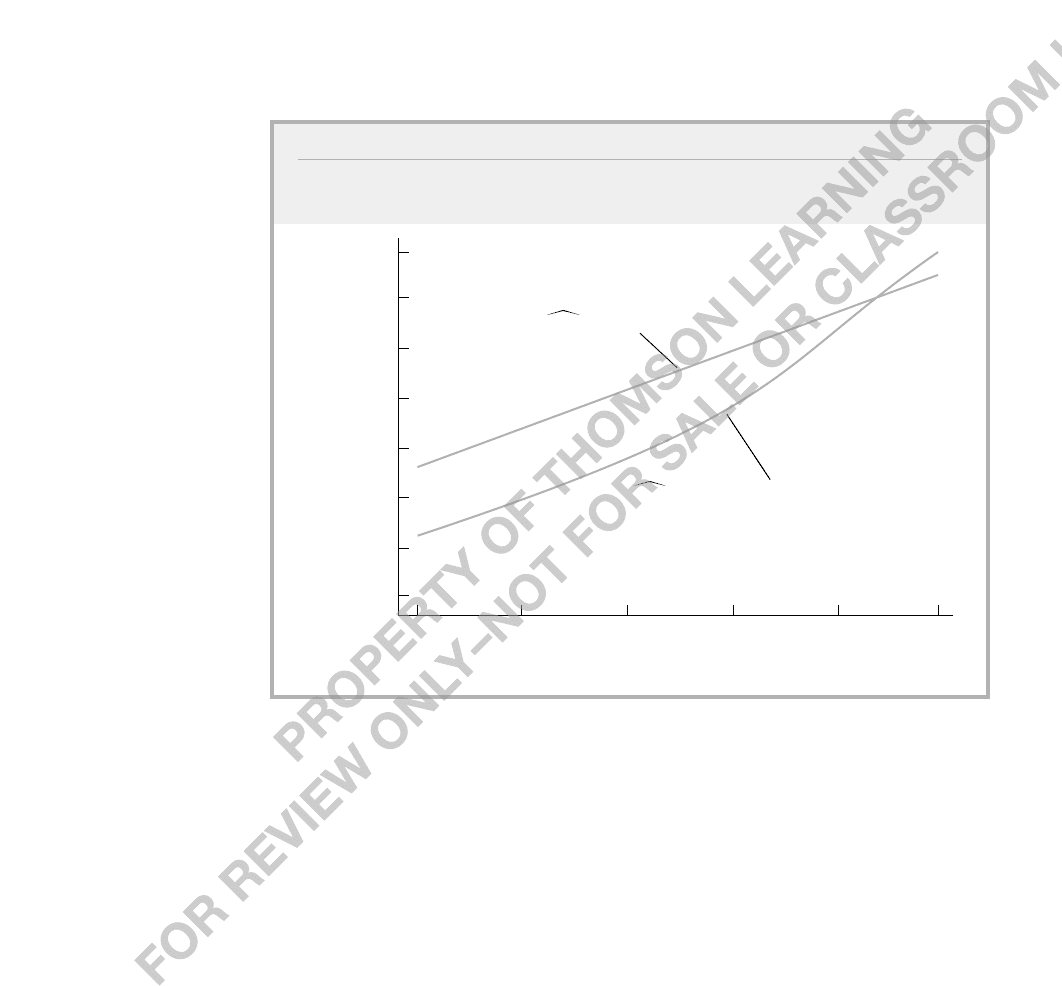Wooldridge J. Introductory Econometrics: A Modern Approach (Basic Text - 3d ed.)
Подождите немного. Документ загружается.


In fact, a linear model might be a good approximation to E(yx
1
,x
2
,…,x
k
), especially for
x
j
near the mean values. But we would possibly obtain negative fitted values, which leads
to negative predictions for y; this is analogous to the problems with the LPM for binary
outcomes. Also, the assumption that an explanatory variable appearing in level form has
a constant partial effect on E(yx) can be misleading. Probably, Var(yx) would be
heteroskedastic, although we can easily deal with general heteroskedasticity by comput-
ing robust standard errors and test statistics. Because the distribution of y piles up at zero,
y clearly cannot have a conditional normal distribution. So all inference would have only
asymptotic justification, as with the linear probability model.
In some cases, it is important to have a model that implies nonnegative predicted values
for y, and which has sensible partial effects over a wide range of the explanatory variables.
Plus, we sometimes want to estimate features of the distribution of y given x
1
, ..., x
k
other
than the conditional expectation. The Tobit model is quite convenient for these purposes.
Typically, the Tobit model expresses the observed response, y, in terms of an underlying
latent variable:
y*
0
x
u, ux ~ Normal(0,
2
)
(17.18)
y max(0,y*). (17.19)
The latent variable y* satisfies the classical linear model assumptions; in particular, it has
a normal, homoskedastic distribution with a linear conditional mean. Equation (17.19)
implies that the observed variable, y, equals y* when y* 0, but y 0 when y* 0.
Because y* is normally distributed, y has a continuous distribution over strictly positive
values. In particular, the density of y given x is the same as the density of y* given x for
positive values. Further,
P(y 0x) P(y* 0x) P(u x
x)
P(u/
x
/
x) (x
/
) 1 (x
/
),
because u/
has a standard normal distribution and is independent of x; we have absorbed
the intercept into x for notational simplicity. Therefore, if (x
i
,y
i
) is a random draw from
the population, the density of y
i
given x
i
is
(2
2
)
1/2
exp[(y x
i
)
2
/(2
2
)] (1/
)
[(y x
i
)/
], y 0
(17.20)
P(y
i
0x
i
) 1 (x
i
/
), (17.21)
where
is the standard normal density function.
From (17.20) and (17.21), we can obtain the log-likelihood function for each obser-
vation i:
i
(
,
) 1(y
i
0)log[1 (x
i
/
)]
1(y
i
0)log{(1/
)
[(y
i
x
i
)/
]};
(17.22)
notice how this depends on
, the standard deviation of u, as well as on the
j
. The log-
likelihood for a random sample of size n is obtained by summing (17.22) across all i. The
596 Part 3 Advanced Topics

maximum likelihood estimates of
and
are obtained by maximizing the log-
likelihood; this requires numerical meth-
ods, although in most cases this is easily
done using a packaged routine.
As in the case of logit and probit, each
Tobit estimate comes with a standard error,
and these can be used to construct t statis-
tics for each
ˆ
j
; the matrix formula used to find the standard errors is complicated and
will not be presented here. (See, for example, Wooldridge [2002, Chapter 16].)
Testing multiple exclusion restrictions is easily done using the Wald test or the
likelihood ratio test. The Wald test has a similar form to the logit or probit case; the LR
test is always given by (17.12), where, of course, we use the Tobit log-likelihood func-
tions for the restricted and unrestricted models.
Interpreting the Tobit Estimates
Using modern computers, the maximum likelihood estimates for Tobit models are usually
not much more difficult to obtain than the OLS estimates of a linear model. Further, the
outputs from Tobit and OLS are often similar. This makes it tempting to interpret the
ˆ
j
from Tobit as if these were estimates from a linear regression. Unfortunately, things are
not so easy.
From equation (17.18), we see that the
j
measure the partial effects of the x
j
on
E(y*x), where y* is the latent variable. Sometimes, y* has an interesting economic mean-
ing, but more often it does not. The variable we want to explain is y, as this is the observed
outcome (such as hours worked or amount of charitable contributions). For example, as a
policy matter, we are interested in the sensitivity of hours worked to changes in marginal
tax rates.
We can estimate P(y 0x) from (17.21), which, of course, allows us to estimate
P(y 0x). What happens if we want to estimate the expected value of y as a function of
x? In Tobit models, two expectations are of particular interest: E(yy 0,x), which is
sometimes called the “conditional expectation” because it is conditional on y 0, and
E(yx), which is, unfortunately, called the “unconditional expectation.” (Both expectations
are conditional on the explanatory variables.) The expectation E(yy 0,x) tells us, for
given values of x, the expected value of y for the subpopulation where y is positive. Given
E(yy 0,x), we can easily find E(yx):
E(yx) P(y 0x)E(yy 0,x) (x
/
)E(yy 0,x).
(17.23)
To obtain E(yy 0,x), we use a result for normally distributed random variables:
if z ~ Normal(0,1), then E(zz c)
(c)/[1 (c)] for any constant c. But E(yy
0,x) x
E(uu x
) x
E[(u/
)(u/
) x
/
] x
(x
/
)/(x
/
),
because
(c)
(c), 1 (c) (c), and u/
has a standard normal distribution
independent of x.
Chapter 17 Limited Dependent Variable Models and Sample Selection Corrections 597
Let y be the number of extramarital affairs for a married woman
from the U.S. population; we would like to explain this variable in
terms of other characteristics of the woman—in particular,
whether she works outside of the home—her husband, and her
family. Is this a good candidate for a Tobit model?
QUESTION 17.3

We can summarize this as
E(yy 0,x) x
(x
/
), (17.24)
where
(c)
(c)/(c) is called the inverse Mills ratio; it is the ratio between the stan-
dard normal pdf and standard normal cdf, each evaluated at c.
Equation (17.24) is important. It shows that the expected value of y conditional on
y 0 is equal to x
plus a strictly positive term, which is
times the inverse Mills ratio
evaluated at x
/
. This equation also shows why using OLS only for observations where
y
i
0 will not always consistently estimate
; essentially, the inverse Mills ratio is an
omitted variable, and it is generally correlated with the elements of x.
Combining (17.23) and (17.24) gives
E(yx) (x
/
)[x
(x
/
)] (x
/
)x
(x
/
), (17.25)
where the second equality follows because (x
/
)
(x
/
)
(x
/
). This equation
shows that when y follows a Tobit model, E(yx) is a nonlinear function of x and
.
Although it is not obvious, the right-hand side of equation (17.25) can be shown to be pos-
itive for any values of x and
. Therefore, once we have estimates of
, we can be sure
that predicted values for y—that is, estimates of E(yx)—are positive. The cost of ensur-
ing positive predictions for y is that equation (17.25) is more complicated than a linear
model for E(yx). Even more importantly, the partial effects from (17.25) are more com-
plicated than for a linear model. As we will see, the partial effects of x
j
on E(yy 0,x)
and E(yx) have the same sign as the coefficient,
j
,but the magnitude of the effects
depends on the values of all explanatory variables and parameters. Because
appears in
(17.25), it is not surprising that the partial effects depend on
, too.
If x
j
is a continuous variable, we can find the partial effects using calculus. First,
∂E(yy 0,x)/∂x
j
j
j
(x
/
),
assuming that x
j
is not functionally related to other regressors. By differentiating
(c)
(c)/(c) and using d/dc
(c) and d
/dc c
(c), it can be shown that d
/dc
(c)
[c
(c)]. Therefore,
∂E(yy 0,x)/∂x
j
j
{1
(x
/
)[x
/
(x
/
)]}. (17.26)
This shows that the partial effect of x
j
on E(yy 0,x) is not determined just by
j
.
The adjustment factor is given by the term in brackets, {}, and depends on a linear func-
tion of x, x
/
(
0
1
x
1
…
k
x
k
)/
. It can be shown that the adjustment factor
is strictly between zero and one. In practice, we can estimate (17.26) by plugging in the
MLEs of the
j
and
. As with logit and probit models, we must plug in values for the x
j
,
usually the mean values or other interesting values. Equation (17.26) reveals a subtle
point that is sometimes lost in applying the Tobit model to corner solution responses: the
d
dc
598 Part 3 Advanced Topics

parameter
appears directly in the partial effects, so having an estimate of
is crucial
for estimating the partial effects. Sometimes,
is called an “ancillary” parameter (which
means it is auxiliary, or unimportant). Although it is true that the value of
does not affect
the sign of the partial effects, it does affect the magnitudes, and we are often interested in
the economic importance of the explanatory variables. Therefore, characterizing
as
ancillary is misleading and comes from a confusion between the Tobit model for corner
solution applications and applications to true data censoring. (See Section 17.4.)
All of the usual economic quantities, such as elasticities, can be computed. For exam-
ple, the elasticity of y with respect to x
1
, conditional on y 0, is
.
(17.27)
This can be computed when x
1
appears in various functional forms, including level, log-
arithmic, and quadratic forms.
If x
1
is a binary variable, the effect of interest is obtained as the difference between
E(yy 0,x), with x
1
1 and x
1
0. Partial effects involving other discrete variables
(such as number of children) can be handled similarly.
We can use (17.25) to find the partial derivative of E(yx) with respect to continuous
x
j
. This derivative accounts for the fact that people starting at y 0 might choose y 0
when x
j
changes:
E(yy 0,x) P(y 0x) .
(17.28)
Because P(y 0x) (x
/
),
(
j
/
)
(x
/
),
(17.29)
so we can estimate each term in (17.28), once we plug in the MLEs of the
j
and
and
particular values of the x
j
.
Remarkably, when we plug (17.26) and (17.29) into (17.28) and use the fact that
(c)
(c)
(c) for any c, we obtain
j
(x
/
).
(17.30)
Equation (17.30) allows us to roughly compare OLS and Tobit estimates. [Equation
(17.30) also can be derived directly from equation (17.25) using the fact that d
(z)/dz
z
(z).] The OLS slope coefficients, say,
ˆ
j
,from the regression of y
i
on x
i1
,x
i2
,..., x
ik
,
∂E(yx)
∂x
j
∂P(y 0x)
∂x
j
∂E(yy 0,x)
∂x
j
∂P(y 0x)
∂x
j
∂E(yx)
∂x
j
x
1
E(yy 0,x)
∂E(yy 0,x)
∂x
1
Chapter 17 Limited Dependent Variable Models and Sample Selection Corrections 599

i 1,...,n—that is, using all of the data—are direct estimates of ∂E(yx)/∂x
j
. To make the Tobit
coefficient,
ˆ
j
, comparable to
ˆ
j
,we must multiply
ˆ
j
by an adjustment factor.
As in the probit and logit cases, there are two common approaches for computing an
adjustment factor for the coefficients on the continuous explanatory variables. First, we
can evaluate (x
ˆ
/
ˆ) at the sample averages to obtain (x
–
ˆ
/
ˆ). Or, second, we can aver-
age the individual adjustment factors: n
1
n
i1
(x
–
i
ˆ
/
ˆ). For comparing scaled Tobit coef-
ficients to OLS coefficients, the latter scale factor generally is more appropriate. Because
P(y 0|x) (x
–
i
ˆ
/
ˆ) both scale factors will tend to be closer to one when there are
relatively few observations with y
i
0. In the extreme case that all y
i
0, the Tobit
and OLS estimates are identical.
Unfortunately, for discrete explanatory variables, comparing OLS and Tobit estimates
is not so easy (although using the scale factor for continuous explanatory variables often
is a useful approximation). For Tobit, the partial effect of a discrete explanatory variable,
for example, a binary variable, should really be obtained by estimating E(y|x) from equa-
tion (17.25). For example, if x
1
is a binary, we should first plug in x
1
1 and then x
1
0.
If we set the other explanatory variables at their sample averages, we obtain a measure
analogous to (17.16) for the logit and probit cases. If we compute the difference in
expected values for each individual, and then average the difference, we get a measure
analogous to (17.17).
EXAMPLE 17.2
(Married Women’s Annual Labor Supply)
The file MROZ.RAW includes data on hours worked for 753 married women, 428 of whom
worked for a wage outside the home during the year; 325 of the women worked zero hours.
For the women who worked positive hours, the range is fairly broad, extending
from 12 to 4,950. Thus, annual hours worked is a good candidate for a Tobit model. We also
estimate a linear model (using all 753 observations) by OLS. The results are given in Table 17.2.
This table has several noteworthy features. First, the Tobit coefficient estimates have the
same sign as the corresponding OLS estimates, and the statistical significance of the esti-
mates is similar. (Possible exceptions are the coefficients on nwifeinc and kidsge6, but the
t statistics have similar magnitudes.) Second, though it is tempting to compare the magni-
tudes of the OLS and Tobit estimates, this is not very informative. We must be careful not to
think that, because the Tobit coefficient on kidslt6 is roughly twice that of the OLS coefficient,
the Tobit model implies a much greater response of hours worked to young children.
We can multiply the Tobit estimates by appropriate adjustment factors to make them
roughly comparable to the OLS estimates. The factor
n
1
n
i1
(x
i
ˆ
/
ˆ)turns out to be about
.589, which we can use to obtain the average partial effects for the Tobit estimation. If, for
example, we multiply the educ coefficient by .589 we get .589(80.65) 47.50 (that is, 47.5
hours more), which is quite a bit larger than the OLS partial effect, about 28.8 hours. So, even
for estimating an average effect, the Tobit estimates are notably larger in magnitude than the
corresponding OLS estimate. If, instead, we want the estimated effect of another year of edu-
cation starting at the average values of all explanatory variables, then we compute the scale
600 Part 3 Advanced Topics

TABLE 17.2
OLS and Tobit Estimation of Annual Hours Worked
Dependent Variable: hours
Independent Linear Tobit
Variables (OLS) (MLE)
nwifeinc 3.45 8.81
(2.54) (4.46)
educ 28.76 80.65
(12.95) (21.58)
exper 65.67 131.56
(9.96) (17.28)
exper
2
.700 1.86
(.325) (0.54)
age 30.51 54.41
(4.36) (7.42)
kidslt6 442.09 894.02
(58.85) (111.88)
kidsge6 32.78 16.22
(23.18) (38.64)
constant 1,330.48 965.31
(270.78) (446.44)
Log-Likelihood Value — 3,819.09
R-Squared .266 .274
ˆ
750.18 1,122.02
factor (x
ˆ
/
ˆ). This turns out to be about .645 [when we use the squared average of expe-
rience, (exper)
2
, rather than the average of exper
2
] This partial effect, which is about 52 hours,
is almost twice as large as the OLS estimate. With the exception of kidsge6, the scaled Tobit
slope coefficients are all greater in magnitude than the corresponding OLS coefficient.
We have reported an R-squared for both the linear regression and the Tobit models. The
R-squared for OLS is the usual one. For Tobit, the R-squared is the square of the correlation
Chapter 17 Limited Dependent Variable Models and Sample Selection Corrections 601

coefficient between y
i
and y
ˆ
i
, where y
ˆ
i
(x
i
ˆ
/
ˆ
)x
i
ˆ
ˆ
(x
i
ˆ
/
ˆ
) is the estimate of
E(yx x
i
). This is motivated by the fact that the usual R-squared for OLS is equal to the
squared correlation between the y
i
and the fitted values [see equation (3.29)]. In nonlinear
models such as the Tobit model, the squared correlation coefficient is not identical to an
R-squared based on a sum of squared residuals as in (3.28). This is because the fitted values,
as defined earlier, and the residuals, y
i
y
ˆ
i
, are not uncorrelated in the sample. An
R-squared defined as the squared correlation coefficient between y
i
and y
ˆ
i
has the advantage
of always being between zero and one; an R-squared based on a sum of squared residuals
need not have this feature.
We can see that, based on the R-squared measures, the Tobit conditional mean function
fits the hours data somewhat, but not substantially, better. However, we should remember
that the Tobit estimates are not chosen to maximize an R-squared—they maximize the log-
likelihood function—whereas the OLS estimates are the values that do produce the highest
R-squared given the linear functional form.
By construction, all of the Tobit fitted values for hours are positive. By contrast, 39 of the OLS
fitted values are negative. Although negative predictions are of some concern, 39 out of 753 is
just over 5% of the observations. It is not entirely clear how negative fitted values for OLS trans-
late into differences in estimated partial effects. Figure 17.3 plots estimates of E(hoursx) as a
function of education; for the Tobit model, the other explanatory variables are set at their aver-
age values. For the linear model, the equation graphed is hours 387.19 28.76 educ. For
the Tobit model, the equation graphed is hours [(694.12 80.65 educ)/1,122.02]
(694.12 80.65 educ) 1,122.02
[(694.12 80.65 educ)/1,122.02]. As can be seen
from the figure, the linear model gives notably higher estimates of the expected hours worked
at even fairly high levels of education. For example, at eight years of education, the OLS pre-
dicted value of hours is about 617.5, while the Tobit estimate is about 423.9. At 12 years of
education, the predicted hours are about 732.7 and 598.3, respectively. The two prediction lines
cross after 17 years of education, but no woman in the sample has more than 17 years of edu-
cation. The increasing slope of the Tobit line clearly indicates the increasing marginal effect of
education on expected hours worked.
Specification Issues in Tobit Models
The Tobit model, and in particular the formulas for the expectations in (17.24) and (17.25),
rely crucially on normality and homoskedasticity in the underlying latent variable model.
When E(yx)
0
1
x
1
…
k
x
k
,we know from Chapter 5 that conditional nor-
mality of y does not play a role in unbiasedness, consistency, or large sample inference.
Heteroskedasticity does not affect unbiasedness or consistency of OLS, although we must
compute robust standard errors and test statistics to perform approximate inference. In a
Tobit model, if any of the assumptions in (17.18) fail, then it is hard to know what the Tobit
MLE is estimating. Nevertheless, for moderate departures from the assumptions, the Tobit
model is likely to provide good estimates of the partial effects on the conditional means. It
is possible to allow for more general assumptions in (17.18), but such models are much
more complicated to estimate and interpret.
602 Part 3 Advanced Topics

One potentially important limitation of the Tobit model, at least in certain applications,
is that the expected value conditional on y 0 is closely linked to the probability that
y 0. This is clear from equations (17.26) and (17.29). In particular, the effect of x
j
on
P(y 0x) is proportional to
j
, as is the effect on E(yy 0,x), where both functions
multiplying
j
are positive and depend on x only through x
/
. This rules out some inter-
esting possibilities. For example, consider the relationship between amount of life insur-
ance coverage and a person’s age. Young people may be less likely to have life insurance
at all, so the probability that y 0 increases with age (at least up to a point). Conditional
on having life insurance, the value of policies might decrease with age, since life insur-
ance becomes less important as people near the end of their lives. This possibility is not
allowed for in the Tobit model.
One way to informally evaluate whether the Tobit model is appropriate is to estimate
a probit model where the binary outcome, say, w, equals one if y 0, and w 0 if y
0. Then, from (17.21), w follows a probit model, where the coefficient on x
j
is
j
j
/
. This means we can estimate the ratio of
j
to
by probit, for each j. If the
Tobit model holds, the probit estimate,
ˆ
j
, should be “close” to
ˆ
j
/
ˆ
,where
ˆ
j
and
ˆ
are
the Tobit estimates. These will never be identical because of sampling error. But we can
look for certain problematic signs. For example, if
ˆ
j
is significant and negative, but
ˆ
j
is
positive, the Tobit model might not be appropriate. Or, if
ˆ
j
and
ˆ
j
are the same sign, but
Chapter 17 Limited Dependent Variable Models and Sample Selection Corrections 603
FIGURE 17.3
Estimated Expected Values of Hours with Respect to Education for the Linear and
Tobit Models.
Estimated Expected Hours
20
1,050
0
Years of Education
900
750
600
450
150
300
12 160 4 8
hours 387.19 28.76 educ
hours [(694.12 80.65 educ)/1,122.02]
(694.12 80.65 educ) 1,122.02
f[(694.12 80.65 educ)/1,122.02]

ˆ
j
/
ˆ
is much larger or smaller than
ˆ
j
, this could also indicate problems. We should not
worry too much about sign changes or magnitude differences on explanatory variables that
are insignificant in both models.
In the annual hours worked example,
ˆ
1,122.02. When we divide the Tobit
co-efficient on nwifeinc by
ˆ,
we obtain 8.81/1,122.02 .0079; the probit coeffi-
cient on nwifeinc is about .012, which is different, but not dramatically so. On
kidslt6, the coefficient estimate over
ˆ
is about .797, compared with the probit estimate
of .868. Again, this is not a huge difference, but it indicates that having small children
has a larger effect on the initial labor force participation decision than on how many hours
a woman chooses to work once she is in the labor force. (Tobit effectively averages these
two effects together.) We do not know whether the effects are statistically different, but
they are of the same order of magnitude.
What happens if we conclude that the Tobit model is inappropriate? There are
models, usually called hurdle or two-part models, that can be used when Tobit seems
unsuitable. These all have the property that P(y 0x) and E(yy 0,x) depend on dif-
ferent parameters, so x
j
can have dissimilar effects on these two functions. (See Woold-
ridge [2002, Chapter 16] for a description of these models.)
17.3 The Poisson Regression Model
Another kind of nonnegative dependent variable is a count variable,which can take on
nonnegative integer values: {0,1,2,…}. We are especially interested in cases where y takes
on relatively few values, including zero. Examples include the number of children ever
born to a woman, the number of times someone is arrested in a year, or the number of
patents applied for by a firm in a year. For the same reasons discussed for binary and Tobit
responses, a linear model for E(yx
1
,…,x
k
) might not provide the best fit over all values
of the explanatory variables. (Nevertheless, it is always informative to start with a linear
model, as we did in Example 3.5.)
As with a Tobit outcome, we cannot take the logarithm of a count variable because it
takes on the value zero. A profitable approach is to model the expected value as an expo-
nential function:
E(yx
1
,x
2
,…,x
k
) exp(
0
1
x
1
…
k
x
k
).
(17.31)
Because exp() is always positive, (17.31) ensures that predicted values for y will also be
positive. The exponential function is graphed in Figure A.5 of Appendix A.
Athough (17.31) is more complicated than a linear model, we basically already know
how to interpret the coefficients. Taking the log of equation (17.31) shows that
log[E(yx
1
,x
2
,…,x
k
)]
0
1
x
1
…
k
x
k
,
(17.32)
so that the log of the expected value is linear. Therefore, using the approximation proper-
ties of the log function that we have used often in previous chapters,
%E(yx) (100
j
)x
j
.
604 Part 3 Advanced Topics

In other words, 100
j
is roughly the percentage change in E(yx), given a one-unit increase
in x
j
. Sometimes, a more accurate estimate is needed, and we can easily find one by look-
ing at discrete changes in the expected value. Keep all explanatory variables except x
k
fixed
and let x
k
0
be the initial value and x
k
1
the subsequent value. Then, the proportionate change
in the expected value is
[exp(
0
x
k1
k1
k
x
k
1
)/exp(
0
x
k1
k1
k
x
k
0
)] 1 exp(
k
x
k
) 1,
where x
k1
k1
is shorthand for
1
x
1
…
k1
x
k1
, and x
k
x
k
1
x
k
0
. When
x
k
1—for example, if x
k
is a dummy variable that we change from zero to one—then
the change is exp(
k
) 1. Given
ˆ
k
, we obtain exp(
ˆ
k
) 1 and multiply this by 100 to
turn the proportionate change into a percentage change.
By reasoning similar to the linear model, if
j
multiplies log(x
j
), then
j
is an elas-
ticity. The bottom line is that, for practical purposes, we can interpret the coefficients in
equation (17.31) as if we have a linear model, with log(y) as the dependent variable. There
are some subtle differences that we need not study here.
Because (17.31) is nonlinear in its parameters—remember, exp() is a nonlinear
function—we cannot use linear regression methods. We could use nonlinear least squares,
which, just as with OLS, minimizes the sum of squared residuals. It turns out, however,
that all standard count data distributions exhibit heteroskedasticity, and nonlinear least
squares does not exploit this (see Wooldridge [2002, Chapter 12]). Instead, we will rely
on maximum likelihood and the important related method of quasi-maximum likelihood
estimation.
In Chapter 4, we introduced normality as the standard distributional assumption for
linear regression. The normality assumption is reasonable for (roughly) continuous depen-
dent variables that can take on a large range of values. A count variable cannot have a nor-
mal distribution (because the normal distribution is for continuous variables that can take
on all values), and if it takes on very few values, the distribution can be very different from
normal. Instead, the nominal distribution for count data is the Poisson distribution.
Because we are interested in the effect of explanatory variables on y,we must look at
the Poisson distribution conditional on x. The Poisson distribution is entirely determined
by its mean, so we only need to specify E(yx). We assume this has the same form as
(17.31), which we write in shorthand as exp(x
). Then, the probability that y equals the
value h, conditional on x,is
P(y hx) exp[exp(x
)][exp(x
)]
h
/h!, h 0,1, …,
where h! denotes factorial (see Appendix B). This distribution, which is the basis for the
Poisson regression model, allows us to find conditional probabilities for any values of the
explanatory variables. For example, P(y 0x) exp[exp(x
)]. Once we have estimates
of the
j
, we can plug them into the probabilities for various values of x.
Given a random sample {(x
i
,y
i
): i 1,2, …, n}, we can construct the log-likelihood
function:
(
)
n
i1
i
(
)
n
i1
{y
i
x
i
exp(x
i
)},
(17.33)
Chapter 17 Limited Dependent Variable Models and Sample Selection Corrections 605
